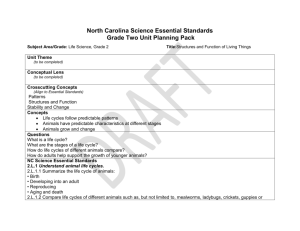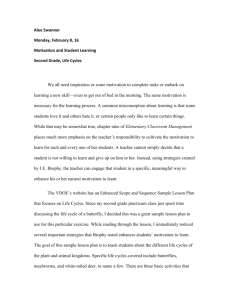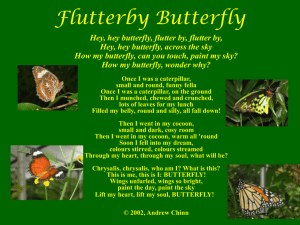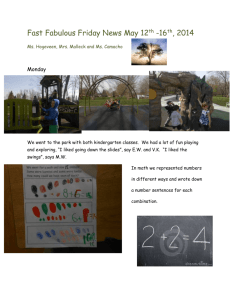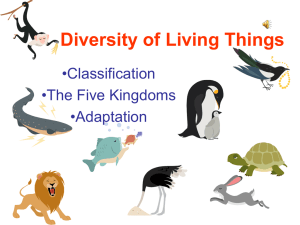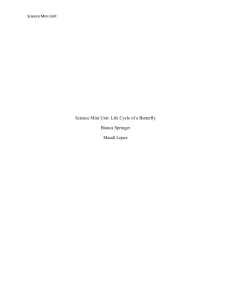Structure and Function Grade 2 Unit Pack
advertisement
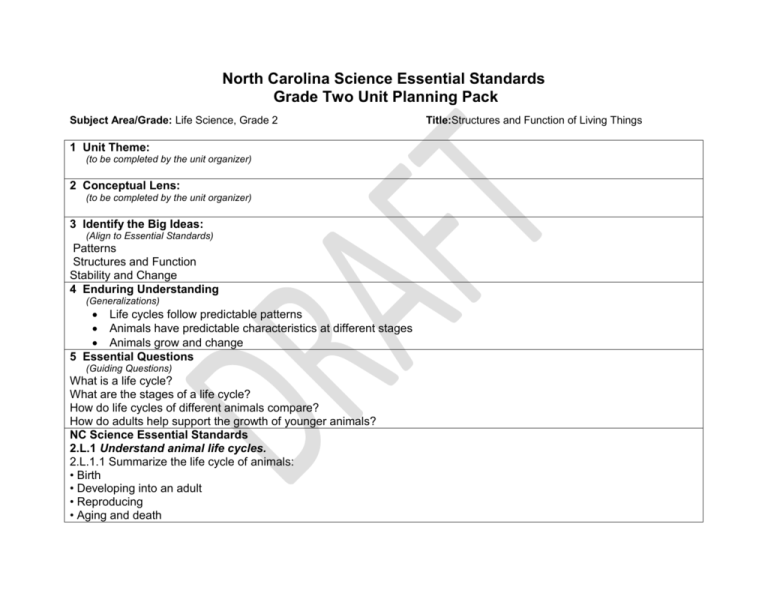
North Carolina Science Essential Standards Grade Two Unit Planning Pack Subject Area/Grade: Life Science, Grade 2 1 Unit Theme: (to be completed by the unit organizer) 2 Conceptual Lens: (to be completed by the unit organizer) 3 Identify the Big Ideas: (Align to Essential Standards) Patterns Structures and Function Stability and Change 4 Enduring Understanding (Generalizations) Life cycles follow predictable patterns Animals have predictable characteristics at different stages Animals grow and change 5 Essential Questions (Guiding Questions) What is a life cycle? What are the stages of a life cycle? How do life cycles of different animals compare? How do adults help support the growth of younger animals? NC Science Essential Standards 2.L.1 Understand animal life cycles. 2.L.1.1 Summarize the life cycle of animals: • Birth • Developing into an adult • Reproducing • Aging and death Title:Structures and Function of Living Things 2.L.1.2 Compare life cycles of different animals such as, but not limited to, mealworms, ladybugs, crickets, guppies or frogs Essential Terminology Birth; adult, reproduce, age, death, lifecycle GRAPHIC ORGANIZERS: How do animals grow and change? http://www.eduplace.com/science/hmsc/content/organizer/1/org_1a_2_3.pdf Baby animals http://www.eduplace.com/science/hmsc/content/organizer/2/org_2a_3.pdf Butterfly life cycle http://www.eduplace.com/science/hmsc/content/organizer/2/org_2a_3_2.pdf Cycle graphic organizers http://www.enchantedlearning.com/graphicorganizers/cycle/ Science For All Americans (minimum ADULT content knowledge) http://www.project2061.org/publications/sfaa/online/chap6.htm#8 NGSS Framework LS1.B: GROWTH AND DEVELOPMENT OF ORGANISMS How do organisms grow and develop? The characteristic structures, functions, and behaviors of organisms change in predictable ways as they progress from birth to old age. For example, upon reaching adulthood, organisms can reproduce and transfer their genetic information to their offspring. Animals engage in behaviors that increase their chances for reproduction, and plants may develop specialized structures and/or depend on animal behavior to accomplish reproduction. Understanding how a single cell can give rise to a complex, multicellular organism builds on the concepts of cell division and gene expression. In multi- cellular organisms, cell division is an essential component of growth, development, and repair. Cell division occurs via a process called mitosis: when a cell divides in two, it passes identical genetic material to two daughter cells. Successive divisions produce many cells. Although the genetic material in each of the cells is identical, small differences in the immediate environments activate or inactivate different genes, which can cause the cells to develop slightly differently. This process of differentiation allows the body to form specialized cells that perform diverse functions, even though they are all descended from a single cell, the fertilized egg. Cell growth and differentiation are the mechanisms by which a fertilized egg develops into a complex organism. In sexual reproduction, a specialized type of cell division called meiosis occurs and results in the production of sex cells, such as gametes (sperm and eggs) or spores, which contain only one member from each chromo- some pair in the parent cell. Grade Band Endpoints for LS1.B By the end of grade 2. Plants and animals have predictable characteristics at different stages of development. Plants and animals grow and change. Adult plants and animals can have young. In many kinds of animals, parents and the offspring themselves engage in behaviors that help the offspring to survive. By the end of grade 5. Reproduction is essential to the continued existence of every kind of organism. Plants and animals have unique and diverse life cycles that include being born (sprouting in plants), growing, developing into adults, reproducing, and eventually dying. Unpacked Content (for students) 2.L.1.1Students know that animals experience a cycle of life which begins with birth, then a period of time in which the animal develops into an adult. At adulthood, animals reproduce in order to sustain their species. In nature, all animals are programmed to age and eventually die. The details of the life cycle are different for specific animals. 2.L.1.2 Students know that different animals spend varying periods of time in each stage of the life cycle and that some animals have few stages, while others have several. Students know that animals might look the same, similar, or completely different at specific stages of development. Students know that animals may have varied needs at different stages of development, and may occupy unique habitats according to these needs. Identify Student Misconceptions *Construct formative assessment probes – see ‘how to’ on pages 85, 102, and 183 in Science Formative Assessment by Page Keeley. Use formative probes: Uncovering Student ideas in Science, Volumes 1-4, by Page Keeley (I) Volume 1 Is it an animal? p. 117 ( II) Volume 3 Does it have a life cycle? p. 111 (III) Volume 3 Sam’s Puppy p. 125 (iV) Volume 4 Chicken Eggs p.105 (modify for grade 2) Formative Assessment Probes (articles, how-to, free-online) by Page Keeley, et al http://pal.lternet.edu/docs/outreach/educators/education_pedagogy_research/assessment_probes_uncovering_student_id eas.pdf http://www.ode.state.or.us/teachlearn/subjects/science/resources/msef2010-formative_assessment_probes.pdf North Carolina Connections: (local and state resources) Imagination Station Science Museum Interactive programs are designed to promote student investigation into various science concepts. 224 East Nash Street, Wilson, NC 27894 Phone (252) 291-5113. North Carolina Museum of Life and Science Experience how inquiry-based teaching energizes your students and encourages science discovery. 433 West Murray Avenue (street address), P.O. Box 15190, Durham, NC 27704, (919) 220-5429 SciWorks, the Science Center and Environmental Park of Forsyth County Enjoy interactive, hands-on special exhibits and programs in spacious exhibit halls. 400 West Hanes Mill Rd., WinstonSalem, (336) 767-6730 North Carolina Museum of Natural Sciences The largest Museum of its kind in the southeast. Wonderful collections and installations related to ecology. 11 West Jones Street Raleigh, NC TEACHER Resources Butterfly Life Cycle http://www.kidsbutterfly.org/ Comparing Life cycles of different animals. http://gets.gc.k12.va.us/elementary/lifecycles/index.htm Video of monarch life cycle http://www.youtube.com/watch?v=Ry4hqn0WD60 Video of ladybug life cycle http://www.youtube.com/watch?v=SvHWxDjfFB8&feature=related Journey North Monarch Butterfly Migration Project http://www.learner.org/jnorth/monarch/index.html Observing the life cycle of a butterfly http://sciencenetlinks.com/lessons/butterfly-1-observing-the-life-cycle-of-a-butterfly/ Puppeteer version of monarch life cycle. Has Arts integration opportunities. http://artsedge.kennedy-center.org/multimedia/VideoStories/hobey-ford/hobey-ford-butterfly.aspx Dancing the life cycle of the butterfly- arts integration http://artsedge.kennedy-center.org/educators/lessons/grade-k-2/Butterfly_Dance.aspx#Instruction Mealworm facts, life cycle activities http://www.ehow.com/info_8337774_mealworms-kids.html Butterfly life cycle activities http://www.enchantedlearning.com/subjects/butterflies/activities/ North American Butterfly Association http://www.naba.org/ Project Wild http://www.projectwild.org/overview.htm This is a supplementary, interdisciplinary, instructional program focused on wildlife that is helpful for educators of students in kindergarten through high school Project learning Tree http://www.plt.org/ An award-winning environmental education program designed for teachers and other educators, parents, and community leaders working with youth from preschool through grade 12. N.C. Environmental Education http://www.ee.enr.state.nc.us/index.asp The N.C. Office of Environmental Education in the N.C. Department of Environment and Natural Resources was established to increase environmental literacy and natural resource stewardship in North Carolina by encouraging, promoting and supporting environmental education programs, facilities and resources throughout the state. The office serves as North Carolina’s clearinghouse, or central source, for all of the environmental education resources in the state. Bee life cycle http://library.thinkquest.org/5382/lifecycle.html Butterfly life cycle http://library.thinkquest.org/J002124/lcycle.htm Looking at life cycles http://www.bbsrc.ac.uk/web/FILES/Resources/discovery6.pdf Dragonfly TV (video and lessons) http://pbskids.org/dragonflytv/show/butterflywings.html Creature Features (search by animal) http://kids.nationalgeographic.com/kids/animals/creaturefeature/monarch-butterflies/ http://kids.nationalgeographic.com/kids/animals/creaturefeature/ladybug/ http://kids.nationalgeographic.com/kids/animals/creaturefeature/red-eyed-tree-frogs/ Smart Exchange http://exchange.smarttech.com/search.html A directory of Smart Board lessons that teachers can download and use. Teachers Domain http://www.teachersdomain.org/resource/tdc02.sci.life.cyc.lp_lifecycle/ frogs, dragonflies and butterflies, video and lesson with card matching READING Resources (scroll to informational text) http://www.ncpublicschools.org/docs/acre/standards/common-core-tools/exemplar/ela.pdf http://www.ncpublicschools.org/acre/standards/common-core-tools/ WRITING PROMPTS 1. With guidance and support from adults, use a variety of digital tools to produce and publish writing – to illustrate the life cycle of a butterfly (or other selected organism) 2. Keep an observation log. Illustrate and record information about the organism you are observing. 3. Write an informative text, which explains the life cycle of an organism. Describe what happens at each stage. 4. Create an opinion piece: Write a description of the most beautiful butterfly you have ever seen. 5. Write an imaginary story about the day you turned into a butterfly.
